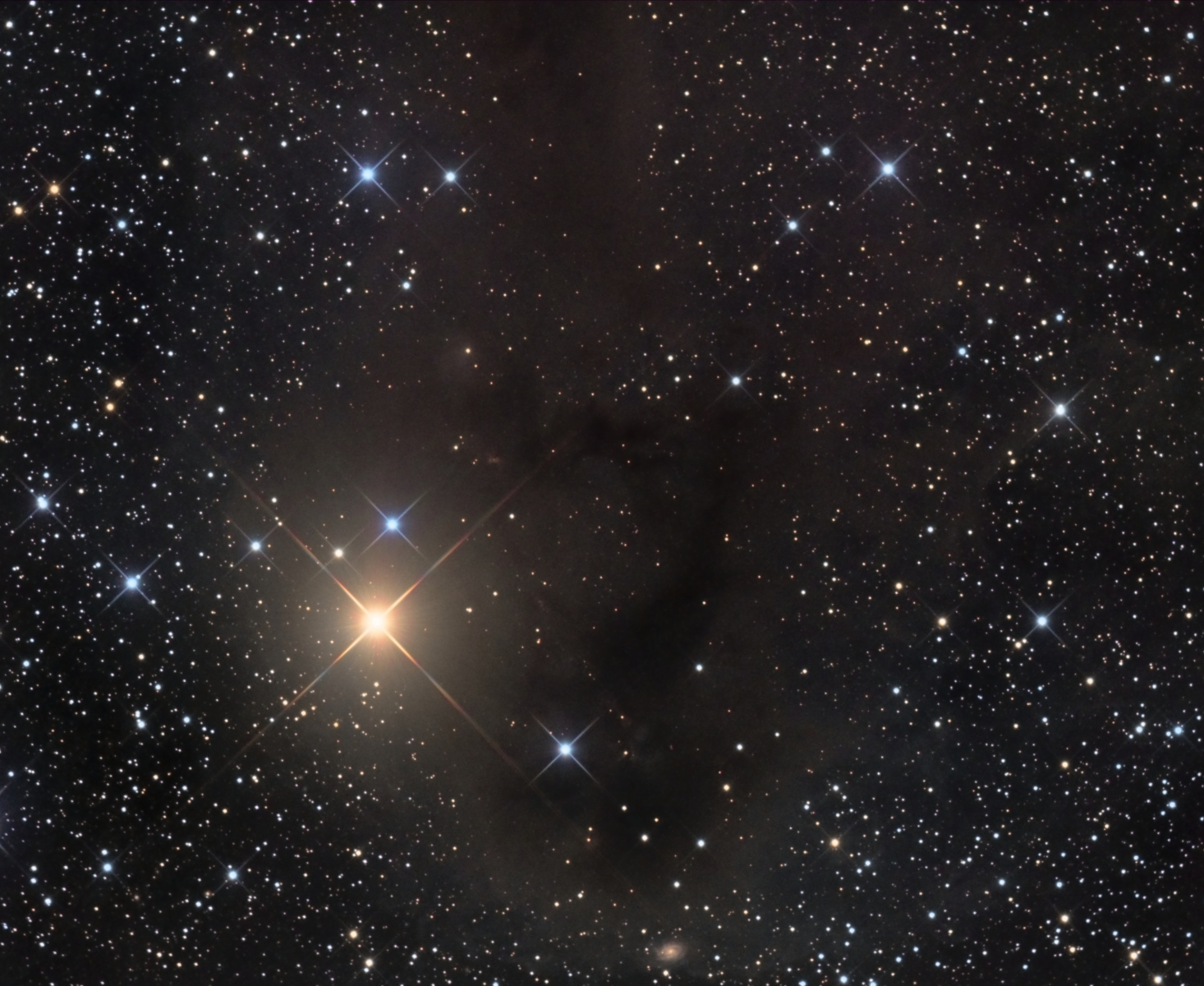LDN1251, Dark Nebula
 Click image for full size version
Click image for full size version
October 30, 2015, Amateur Astronomy Picture of the Day, Dec. 29 2015
 LDN1251 is a complex nebula in the constellation Cepheus, containing dark structures and faintly glowing / reflecting dust and gas. This type of object is sometimes referred to as a molecular cloud, and this one is quite close to us at around 1,000 light years. It is part of a much large complex of bright and dark nebulae. Near the bottom of the image is a bonus object: little PGC69472, a spiral galaxy that reminds me a bit of M33 (which I’ll be shooting again at higher resolution in the coming weeks). This image also contains numerous Herbig-Haro objects associated with LDN1251. These are visible as small patches of nebulosity associated with newly born stars. Two of the more obvious HH objects in this image are slightly above left of centre and below left of centre.
LDN1251 is a complex nebula in the constellation Cepheus, containing dark structures and faintly glowing / reflecting dust and gas. This type of object is sometimes referred to as a molecular cloud, and this one is quite close to us at around 1,000 light years. It is part of a much large complex of bright and dark nebulae. Near the bottom of the image is a bonus object: little PGC69472, a spiral galaxy that reminds me a bit of M33 (which I’ll be shooting again at higher resolution in the coming weeks). This image also contains numerous Herbig-Haro objects associated with LDN1251. These are visible as small patches of nebulosity associated with newly born stars. Two of the more obvious HH objects in this image are slightly above left of centre and below left of centre.
The acronym “LDN” refers to Lynd’s Catalogue of Dark Nebulae. This catalogue’s entries were identified by inspection of red and blue images from the National Geographic – Palomar Observatory Sky Atlas.
Tekkies:
SBIG STL-11000M camera, Baader LRGB filters, 10″ f/6.8 ASA astrograph, Paramount MX. Guided with QHY5 camera and 80 mm f/6 Stellar-Vue refractor. Acquisition and guiding with TheSkyX. Focusing with FocusMax. Automation with CCDCommander. Calibration, cosmetic correction, registration, integration and all processing in PixInsight. Shot from my SkyShed in Guelph, Ontario. No moon, average to good transparency and fair to average seeing throughout acquisition.
10x15m R, 10x15m G, 10x15m B and 25x15m L unbinned frames (total=13hr45m).
RGB:
R, G and B masters were combined and the resulting RGB image was cropped, processed with DBE and colour balanced with ColourCalibration. MultiscaleLinearTransform was applied to reduce the noise prior to stretching. Layer settings for threshold and strength: Layer 1: 3.0, 0.7 Layer 2: 2.0, 0.5 Layer 3: 1.0, 0.35 Layer 4: 0.5, 0.15. HistogramTransformation was applied to make a pleasing yet bright image. TGV Noise was applied and the image was re-stretched to reset the black point. A slight curve was applied to increase contrast and brightness.
Synthetic Luminance:
Creation and cleanup: The cleaned up L, R,G and B masters were combined using the ImageIntegration tool (average, additive with scaling, noise evaluation, iterative K-sigma / biweight midvariance, no pixel rejection). ImageRegistration was used to register the SynthL to the RGB image.
Linear Noise Reduction: MultiscaleLinearTransform was applied to reduce the noise prior to stretching with the same layer settings as above.
Stretching: HistogramTransformation was applied to make a pleasing yet bright image. ACDNR was applied, followed by HistogramTransformation to reset the black point.
Combining SynthL with HaRGB:
The luminance channel of the RGB image was extracted, processed and then added back into the RGB image as follows:
1. Extract luminance from the RGB image.
2. Apply LinearFit using SynthL as the reference.
3. Use ChannelCombination in Lab mode to replace the RGB’s luminance with the fitted luminance from step 2.
4. LRGBCombine was then used to make a SynthLRGB image.
Final Processing
The Curves tool was used to increase contrast overall, and to increase colour saturation in the stars and dusty areas of the image. The DarkStructureEnhance script was used to make a mask, which was used to reduce the darkest areas of the nebula (which showed the most noise).
Image scale is about 1.1 arcsec per pixel for this camera / telescope combination.






Amazing technic Ron …congratulations. ..
I’m glad you like it and hope you find the processing information helpful.